The Most Helpful Guide in Nutrition Label For The Unfamiliar
Reading nutrition labels is a simple task. Yet, many people still find themselves confused when looking at the label. The best place to start is to look at the serving size. The serving size on the package is determined by the manufacturer. Once you have determined what the manufacturer means by a serving, you can move on to other sections of the nutrition label.
The first thing to know about nutrition labels is that they are not equal. Food manufacturers have some flexibility when designing their labels. It's essential to read them carefully.
Nutrition labels are one of the best ways to inform consumers about the ingredients and content of their products. Nutrition labels allow consumers to make more informed buying decisions. It helps them understand the nutritional value of your product.
However, if you're unfamiliar with how nutrition labels work, follow along for an easy guide.
Nutrition labels are not just for nutritionists anymore
The FDA has taken a big step towards making food labels easier to understand. They also made it more accessible to consumers. The new label has been designed to help us make wiser choices based on our health needs.
One of the goals of this re-design is to make it easier to identify what nutrients we want to consume more or less of. This is why the calorie count is now in bold and added sugars are a highlighted nutrient.
Nutrition labels can help you make informed food choices. It can help reduce your risk of developing certain chronic diseases. It's essential to consider the % Daily Values (%DVs) when you're making food choices. A serving of cereal with 10% of the DV of calcium or a serving of milk with 30% of the DV would be considered good sources of calcium.
The FDA requires that nutrition labels include total fat, trans fat, cholesterol, sodium, total carbohydrate and dietary fiber (soluble and insoluble), protein, vitamins A and C, iron, and calories from fat. The %DVs listed on the Nutrition Facts label are based on a 2,000 calorie diet. If you consume more or less than 2,000 calories per day, your intake may be higher or lower than these values.
No matter how healthy you eat, it's essential to know what is in your food. If you are trying to lose weight, control your blood sugar, or get more nutrients. Having an idea of what your food contains will help.
The government requires food manufacturers to list nutritional information on product labels. The information helps people make informed choices about their nutrition and health. But it's easy to get lost in all those numbers, so here's a primer on how to read nutrition labels.
If you do not read food labels, you are missing the chance to make healthier food choices. The food label is your best guide for choosing foods lower in fat, saturated fat, and cholesterol.
By reading food labels, everyone can learn about the nutrients in their foods. They can also learn how those nutrients affect their daily diet. By becoming a savvy consumer and learning to use nutrition labels, you can shop smarter and eat healthier.
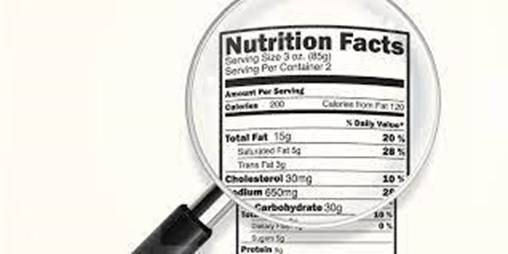
Despite what you might think, it's not that difficult to understand
To make smarter food choices, you have to read and understand nutrition labels. But while nutrition labels can seem intimidating, they don't have to be. With some knowledge and some basic math, you can make sense of these labels. You can use them to make better food choices for your family.
First, we'll go over how nutrients are measured on nutrition labels. Then we'll take a look at what the percent daily value means and how it can help you choose healthy foods for your family.
There are many different ways to read nutrition labels. But the most important thing to look for is the gram amount of added sugar. Make sure to check the serving size and number of servings per container.
It's also a good idea to keep an eye out for high amounts of saturated fat, sodium, and cholesterol. If your diet contains items with high amounts of these ingredients, it's best to cut back.
If you're like most people, you probably don't overthink the nutrition information on food labels. But if you're serious about getting healthier, it's an important thing to learn.
Nutrition labels are designed to help people make better choices about the food they eat. But you could end up making a choice that does more harm than good. That is if you don't understand what the information means.
Before we get into why it's so important to learn how to read food labels, let's look at what makes up a food label and how this information is organized.
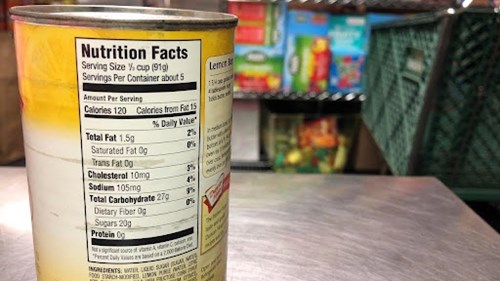
The Food Label: What Does It All Mean?
It's important to remember that all foods come with calories, but not all calories are equal. Calories in healthy foods are usually packed with vitamins, minerals, and fiber. These three things help keep your body functioning correctly. On the other hand, calories in processed foods tend to be empty. They lack nutrients that are vital for health.
Many people don't realize that dietary fiber is essential for good digestive health. That's why you should try to find food with at least 3 grams of fiber per serving.
Here are some other tips to help you better understand nutrition labels:
- Look for foods with less than 5 percent daily value (DV) for sodium and cholesterol. And no more than 20 percent DV of total fat, saturated fat, or added sugar.
- Try to eat various foods so that your diet contains the right amounts of protein, carbohydrates, fats, vitamins, and minerals.
- Try to look at what's in food rather than what's not in it. Instead of looking at foods low in fat or sugar, look for ones containing fiber or complex carbohydrates.
The Nutrition Facts label can be found on packaged foods and beverages. It provides information on calories, types of fat, and nutrients.
The serving size is the amount of food in one container. A package may contain more than one serving. Pay attention to the number of servings in the package and what a serving size looks like. Many people eat more than one serving at a time.
Check the total calories per serving. Calories are a unit of measurement for the amount of energy contained in a portion of a particular meal. The number of calories in a serving tells you how much energy your body will get from that serving. You can compare different foods and see which ones give you more or less energy from the same amount of serving size.
Calories from fat are the number of calories from fat in a single serving. In general, experts recommend that between 25 percent to 35 percent of your daily calories should come from fat. Remember, not all fats are bad for you. Some fats help keep cells healthy, protect your organs and help your body absorb vitamins.
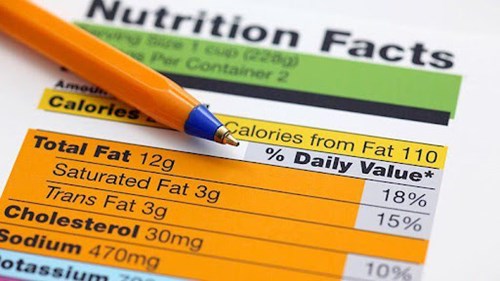
You don't have to become a nutrition expert overnight, but educating yourself a little bit doesn't hurt
As you grow in your knowledge of healthy eating, you can pass on your new habits and insights to your kids.The first step to healthy eating is understanding what you're putting into your body.
Nutrition labels play a significant role in making informed food choices. They include essential information like the number of calories and grams of fat, protein, and carbohydrates in your food. Most labels also list the percentage of the daily value (% DV) for each nutrient — this is the amount of each nutrient that one serving contains compared with how much you need in an entire day.
Look for these critical nutrients across all labels:
Calories: The total number of calories per serving.
Calories from fat: The total number of calories from fat per serving.
% Daily Value (DV): A percentage that tells you how much fat, saturated fat, cholesterol, sodium, carbohydrates, fiber, and sugars are in one serving size compared to the daily amount recommended for a 2,000-calorie diet.
The first step toward improving your gut health is to stop eating junk food. When you eat a balanced diet of whole foods, you'll get more nutrients and fiber, which will promote a healthier microbiome.
You should also try to limit your sugar and alcohol intake. These can cause blood sugar spikes and inflammation, which are bad for the gut microbiome.
In addition to eating well, you might want to consider taking a probiotic supplement. These supplements contain live bacteria that will help improve your intestinal flora. However, there are so many different brands and strains of probiotics on the market that it can be challenging to know what to choose.
Talk with your doctor about the best option for you, but in general, look for something with multiple strains of bacteria and at least 10 billion CFU (colony-forming units).
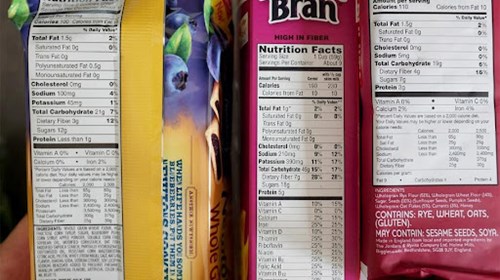
The more you know about the label, the more you'll know about your diet and overall health
In many countries, the Nutrition Facts Label is mandated on most packaged foods. Most countries also provide comprehensive dietary recommendations for general education. Different dietary objectives for various nutrients are used in the guides rather than the labels on specific foods. Australia and New Zealand use an Informative Front of Pack Labeling system based on red, amber, and green coding but without nutrient reference values.
Eating healthy is almost always a good idea. But it's hard to know what kind of nutrients you're getting if you don't know what you're eating. That's where food labels come in. Food labels help us figure out whether that box of cookies is part of a balanced diet by providing a list of ingredients and nutritional information.
While some foods contain added vitamins, minerals, and other nutrients, most are not fortified with anything. That means the food label is your best source of information about how many nutrients you're getting per serving (and whether there are any hidden ingredients to watch out for).
The nutrition information helps you compare products and make informed decisions about what you eat. It can also help prevent several diseases, including heart disease, diabetes, osteoporosis (weak bones), and some cancers.
In addition to the required information on the label, there may be other voluntary nutrition information. This is found in the form of nutrient content claims and health claims. Examples of these include "low fat" or "high in calcium" or "may reduce the risk of cancer."
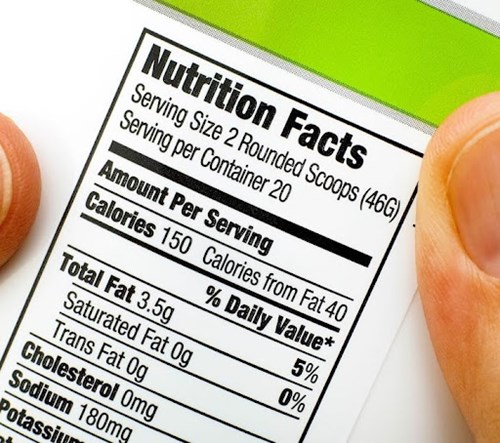
Understanding what you're eating can help you make healthier choices
Food labels are designed to help you make better decisions when you shop. Though they can be a little confusing to read, they're worth it. The more you know about the label, the more you'll know about your diet and overall health.
You should also know that food labels aren't as regulated as people think. The FDA has made efforts to help consumers by putting together a system called Nutrition Facts, but food manufacturers have some wiggle room when it comes to what information they have to disclose.
The Food and Drug Administration regulates the Nutrition Facts label, which sets guidelines for what information has to be included. Even with these regulations, it's up to the food manufacturers to decide what information will be included on their labels and how it will be presented. Because of this, different companies can display the same information in different ways. For example, some may use grams while others use milligrams for vitamins and minerals.
The first number tells you how much your daily recommended value of certain nutrients one serving provides
The first number in the nutrition label tells you how much your daily recommended value of certain nutrients one serving provides. This is important because you want less than what you're supposed to get per day when it comes to calories. But when it comes to things like fiber, calcium, and vitamin A, you want more than what's listed — at least 30% of your daily value, according to the FDA.
For example, a serving of peanut butter might have 16g of fat, according to the nutrition label. If you eat two servings — 32g — and the daily recommended value is 65g, that's almost half of your daily value just from eating peanut butter! Food is considered a "good source" of a nutrient if it has 10 to 19 percent daily value. A "high source" contains 20 percent or more.
If you eat more than one serving, multiply accordingly. Keep in mind that most people eat way more than a single serving of anything, so paying attention to portion size is essential. For example, brownies can have anywhere from 180 to 400 calories per serving, depending on the recipe.
The second number is the amount of fat in a serving. The third number is saturated fat, as low as possible.
The fourth and fifth numbers list sodium and cholesterol, respectively. No more than 23 percent of your total daily sodium intake should come from one meal. So if you consume 2,500 milligrams of sodium each day, no single meal should contain more than 575 milligrams (or less). Cholesterol should be 200 milligrams or less per meal.
The "Daily Value" is based on 2,000 calories a day for adults. Percentages are based on a 2,000 calorie/day diet. For example, if the percent daily value for total fat is 20%, that means that one serving has 20% of the amount of fat you should have each day.
If you eat more than the serving size listed on the nutrition label and eat more than once per day, you'll have to do a little bit of math to determine your percent daily value based on what you ate.
Learning to read nutrition labels takes time, but it's worth the effort
You'll be surprised at how many products don't contain what they seem to contain and how much sugar and fat can be hidden in small packages.
Studies have shown that people tend to eat what they see. If you set out a bowl of chips, you're more likely to mindlessly snack on them than if you put them away in a cupboard or closet. So when you see a tempting food, think about whether it's worth it.
If you find yourself "starving" late in the evening, try having a glass of water or a cup of herbal tea instead. Often our bodies mistake hunger for thirst. If that doesn't help, try eating some fruit or raw vegetables.
You don't have to give up foods you love entirely. Instead of eliminating them from your diet, limit how much of them you eat.
Nutrition labels are complicated, but if you take the time to learn how to read them, it's easier to choose healthy and good foods for your family.
The Nutrition Facts label can help you make informed food choices that are best for your health. For example, the label can help you control your weight, prevent or manage diseases like high blood pressure or diabetes, and promote better overall health.
The next time you're at the grocery store with your kids, have them read the nutrition labels on different items. Then ask them which item they think is healthier based on what they read on the label. Knowing how to read nutrition labels will help you figure out just what's in the food you eat. If you're trying to maintain or lose weight or have specific health concerns.
Here's what you need to know about nutrition labels:
Serving size. Nutrition facts are based on the serving size listed at the label's top. This will tell you how significant a portion of the product has calories and how much of each nutrient it contains. If you're eating more than one serving, you'll have to double or triple everything listed below — including calories and saturated fat.
Calories and calories from fat. These are listed in bold at the top of the label. Pay special attention to calories from fat — it tells you how many of your total daily calories should come from fat. A diet that contains too much-saturated fat raises your risk for heart disease. In general, less than 30 percent of your daily calories should come from fat, with no more than 10 percent coming from saturated fat.
Here are some of the most common ingredients you'll encounter, along with what they mean for your health.
High-fructose corn syrup (HFCS) and sugar. When it comes to sugar, there's not a big difference between HFCS and regular sugar, but both should be consumed in moderation.
Salt. The Food and Drug Administration recommends consuming no more than 2,300 milligrams of sodium per day. However, the average American consumes approximately 3,400 milligrams of sodium daily. Many additives and preservatives use salt as a base ingredient. Thus, it is essential to check for sodium levels on nutrition labels.
Artificial sweeteners. There are three primary types of artificial sweeteners: aspartame, saccharin, and sucralose. Research has yet to determine whether these sweeteners have any adverse effects on health when consumed in moderation over time.
Most food labels contain a "Nutrition Facts" panel that lists how much of each nutrient is contained in one serving of the food product and how much of the daily recommended value is contained in one serving. It is essential to remember that serving sizes vary from product to product.
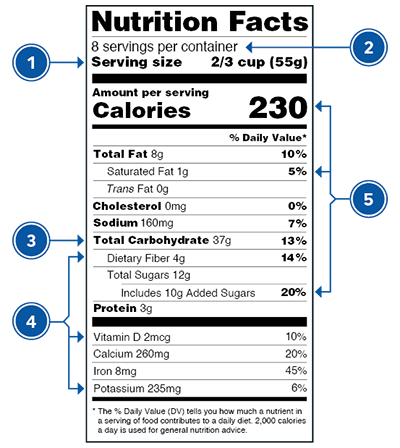
Every nutrition label has six essential components (not including servings)
Understanding nutrition labels is key to making smart food choices, especially if you have diabetes or another health condition requiring watching what you eat. But deciphering those labels is easier said than done. The facts and figures on the side of your favorite foods can be a bit confusing at first glance. Here's how to break down the information so you can determine which foods are right for you.
Six essential components on every nutrition label
Calories: How many calories are in each serving?
Fat: How much fat is in each serving? How much of it is saturated fat?
Cholesterol: How much cholesterol is in each serving?
Sodium: How much sodium is in each serving?
Carbohydrates: How many carbohydrates are in each serving? Are there any sugars or fiber listed?
Protein: How much protein is in each serving?
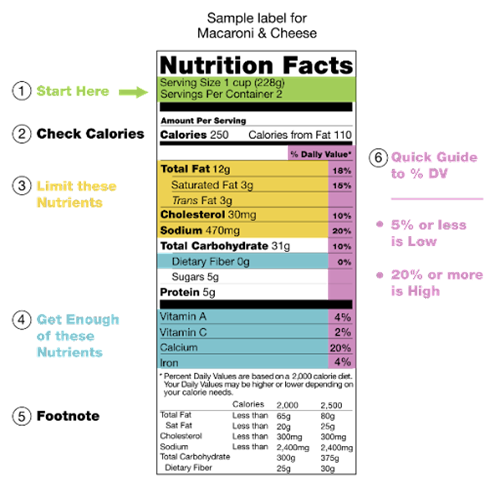
Conclusion
Many people do not realize the importance of nutrition labels and their role in a healthy lifestyle. Nutrition labels are necessary because they help consumers to make informed decisions about what they are consuming. They also help prevent many diseases and disorders caused by poor diet choices. The Nutrition Labeling and Education Act (NLEA) required that all packaged food products provide this information to the public.
The Nutrition Facts Label is a label required on most packaged food in many countries, showing what nutrients (to limit and get enough of) are in the food. The nutrition facts label is usually found on the back or bottom of a product package. It is designed to help people make informed food choices that promote health. The Nutrition Facts Label can be found on perishable and non-perishable food items.
The nutrition label can be seen as a table containing information about the nutrients in a serving size of the food. The nutritional label is regulated by the Food and Drug Administration (FDA) in the United States and by Health Canada at both the federal and provincial levels, with further requirements for specific products in both jurisdictions.
The FDA has proposed less saturated fat, sugar, and sodium content in products. Some companies would not want to change their recipe because they think that consumers will not buy their products as much as they do now if they change their recipes.
As a brand, it's your job to educate consumers on your products. You can do this by showcasing the benefits of your products or services. A common way to educate consumers is through nutrition labels.



